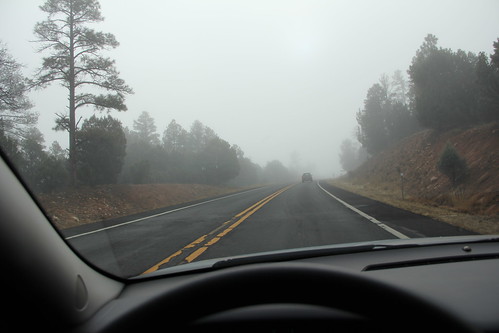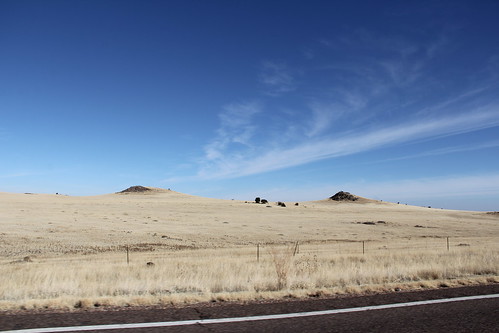Yesterday, I was awake before the neighborhood chickens. I dragged Nelson around the block before heading north and east, driving past Four Peaks just as the sky was beginning to show the first light of day. The saguaros near Roosevelt Lake stood sentry, and by the time I reached the Mogollon Rim at some 6000 feet, a heavy fog clouded the vista. Through the mist, I could make out a few homestead fires on the forest floor, some 2000 feet below. The silver smoke rose in twisting spirals, winding its way upward toward the heavens — and the stream of cars on 260 heading to eastern Arizona.
This drive across Arizona toward New Mexico is forest and brush, high desert and hills. The neighborhoods vary from the odd trailer with a spray painted particle board address sign to multi-million dollar gated golf communities. I drove across several American Indian reservations too, some with flashy neon casinos.
With each curve, wash and bridge, there was a small green sign denoting the place’s name.
Whiskey Springs
Trout Springs
Doubtful Canyon
The last was apt. I spent 10 hours and nearly 500 miles on the road to reach a small rural community in eastern Arizona facing a suicide outbreak. I arrived midday to join colleagues and city officials to review death certificate data and talk strategy. In cities of all sizes, talking about taboo subjects is more about who you know than what you know. I approached the conversation quietly, listening to folks talk about what they’d heard.
How many? How? Where? Why? Related? Who knows?
Is the word “suicide” being used?
As in many communities, this one has pockets full of the like-minded. There are racial, economic and religious delineations. Each is talking about suicide differently — including, for some, not talking about it at all. Trying to unweave this tangle of small town living is not my mission. Working with local leaders to bring representatives from each of these groups together to talk about what they are hearing, seeing and feeling? That’s the challenge.
And thankfully, I was surprised yesterday by the collaboration that has already taken root among faith and town leaders in the last month. There have been strides toward listening and understanding. There have been public conversations, including prayers around the flagpole, about suicide. People are talking about it, even if they don’t want to use the word.
Stigma hides in the shadows of social issues. It can be found in euphemism and feigned ignorance. It’s threaded through insensitive jokes and is used as a derogation.
There should be no stigma with ending suicide. It is possible. Suicide is not “taking one’s life” or “someone passing away,” but the act of killing oneself — just as some 40,000 Americans did last year. (Ample more died of unintentional poisonings, single car accidents or had a failed attempt at suicide.)
While I was hesitant to attend these meetings yesterday, it was full of hope. I drove away incredibly pleased at the new motivation from many partners to work together to identify local resources for mental health.
~K
– If you have thought about suicide and would like to speak with someone — please call: 1 (800) 273-8255. Your life matters.




